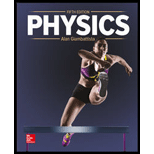
Concept explainers
(a)
The energy and momentum of one laser photon if the laser wavelength is 670 nm .
(a)
Answer to Problem 93P
The energy of the photon is 1.9 eV and its momentum is 9.9×10−28 kg⋅m/s .
Explanation of Solution
Write the equation for the energy of the photon.
E=hcλ (I)
Here, E is the energy of the photons, h is the Planck’s constant, c is the
Write the equation for the energy of the momentum of the photon in terms of energy.
E=pc
Here, p is the momentum of the photon.
Rewrite the above equation for p .
p=Ec (II)
Conclusion:
The value of hc is 1240 eV⋅nm and the value of c is 3.00×108 m/s .
Substitute 1240 eV⋅nm for hc and 670 nm for λ in equation (I) to find E .
E=1240 eV⋅nm670 nm=1.85 eV≈1.9 eV
Substitute 1.85 eV for E and 3.00×108 m/s for c in equation (II) to find p .
p=1.85 eV1.6×10−19 J1 eV3.00×108 m/s=9.9×10−28 kg⋅m/s
Therefore, the energy of the photon is 1.9 eV and its momentum is 9.9×10−28 kg⋅m/s .
(b)
The number of photons per second emitted by the laser.
(b)
Answer to Problem 93P
The number of photons per second emitted by the laser is 3×1015 photons/s .
Explanation of Solution
The number of photons per second emitted by the laser is given by the ratio of power of the laser to the energy per photon.
Write the equation for the rate of photon emission.
rate=PE (III)
Conclusion:
Given that the output power of the laser pointer is 1 mW .
Substitute 1 mW for P and 1.85 eV for E in equation (III) to find the photon emission rate.
rate=(1 mW1 W103 mW)(1.85 eV1.6×10−19 J1 eV)=1×10−3 W2.96×10−19 J=3×1015 photons/s
Therefore, number of photons per second emitted by the laser is 3×1015 photons/s .
(c)
The average force on the laser due to the momentum carried away by the emitted photons.
(c)
Answer to Problem 93P
The average force on the laser due to the momentum carried away by the emitted photons is 3×10−12 N .
Explanation of Solution
The impulse momentum theorem states that the impulse is equal to the change in momentum. The impulse is the product of the average force applied and the time interval during which the force acts.
Write the mathematical expression for the impulse-momentum theorem.
Δp=FavΔt
Here, Δp is the change in momentum, Fav is the average force applied and Δt is the time interval.
Rewrite the above equation for Fav .
Fav=ΔpΔt (IV)
Use equation (II) to write the expression for the change in momentum.
Δp=ΔEc (V)
Write the equation for Δt .
Δt=ΔEP (VI)
Put equations (V) and (VI) in equation (IV).
Fav=ΔE/cΔE/P=Pc (VII)
Conclusion:
Substitute 1 mW for P and 3.00×108 m/s for c in equation (VII) to find Fav .
Fav=(1 mW1 W103 mW)3.00×108 m/s=1×10−3 W3.00×108 m/s=3×10−12 N
Therefore, the average force on the laser due to the momentum carried away by the emitted photons is 3×10−12 N .
Want to see more full solutions like this?
Chapter 27 Solutions
Physics
- Concept Simulation 26.4 provides the option of exploring the ray diagram that applies to this problem. The distance between an object and its image formed by a diverging lens is 5.90 cm. The focal length of the lens is -2.60 cm. Find (a) the image distance and (b) the object distance.arrow_forwardPls help ASAParrow_forwardPls help ASAParrow_forward
 College PhysicsPhysicsISBN:9781305952300Author:Raymond A. Serway, Chris VuillePublisher:Cengage Learning
College PhysicsPhysicsISBN:9781305952300Author:Raymond A. Serway, Chris VuillePublisher:Cengage Learning University Physics (14th Edition)PhysicsISBN:9780133969290Author:Hugh D. Young, Roger A. FreedmanPublisher:PEARSON
University Physics (14th Edition)PhysicsISBN:9780133969290Author:Hugh D. Young, Roger A. FreedmanPublisher:PEARSON Introduction To Quantum MechanicsPhysicsISBN:9781107189638Author:Griffiths, David J., Schroeter, Darrell F.Publisher:Cambridge University Press
Introduction To Quantum MechanicsPhysicsISBN:9781107189638Author:Griffiths, David J., Schroeter, Darrell F.Publisher:Cambridge University Press Physics for Scientists and EngineersPhysicsISBN:9781337553278Author:Raymond A. Serway, John W. JewettPublisher:Cengage Learning
Physics for Scientists and EngineersPhysicsISBN:9781337553278Author:Raymond A. Serway, John W. JewettPublisher:Cengage Learning Lecture- Tutorials for Introductory AstronomyPhysicsISBN:9780321820464Author:Edward E. Prather, Tim P. Slater, Jeff P. Adams, Gina BrissendenPublisher:Addison-Wesley
Lecture- Tutorials for Introductory AstronomyPhysicsISBN:9780321820464Author:Edward E. Prather, Tim P. Slater, Jeff P. Adams, Gina BrissendenPublisher:Addison-Wesley College Physics: A Strategic Approach (4th Editio...PhysicsISBN:9780134609034Author:Randall D. Knight (Professor Emeritus), Brian Jones, Stuart FieldPublisher:PEARSON
College Physics: A Strategic Approach (4th Editio...PhysicsISBN:9780134609034Author:Randall D. Knight (Professor Emeritus), Brian Jones, Stuart FieldPublisher:PEARSON





